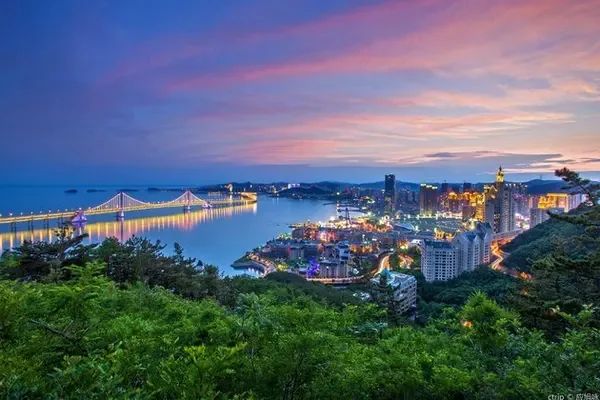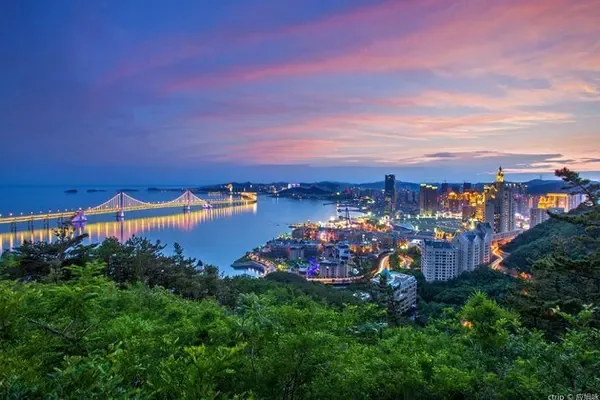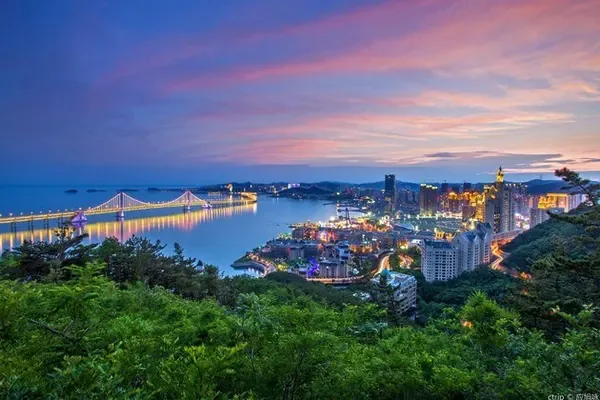A Brief Introduction to the Background of Beipiao Daheishan
Daheishan tourist attraction is located in the northwest of Beipiao City, Liaoning Province, at the junction of Aohan Banner in Inner Mongolia. The scenic area covers an area of 30.31 square kilometers, and the main peak, Pingdingshan, is 1074.3 meters above sea level, the highest peak in Beipiao, known as "the sacred mountain of Yandu, the backbone of Beipiao". It is composed of four divisions, namely Journey to the West Wonderland, Qunfeng Jingxiu, May Ice and Holy Mountain Deer Park, and Shanmen Square. It is a mountain-type leisure and sightseeing tourist scenic spot featuring strange peaks and rocks, Beiguo forest, apricot azalea flowers and fruits, ice waterfall hot springs, red pavilion inscriptions, wild animals and praying Buddhist temples.
Daheishan is famous for its strange rocks and enjoys the reputation of "Kingdom of Strange Rocks". It is said to have thirty strange sights. Strange rocks of various shapes are uncannyly crafted and have profound meanings. As well as hundreds of natural and humanistic scenic spots such as the Tibetan Huiyuan Temple and the Han Dynasty Chanwu Temple, the beauty is so beautiful that it makes people linger and forget to return.
Barrier-free plank road in Journey to the West Wonderland Scenic Area, the first "Chinese filial piety" in the country
Take a battery car to the Journey to the West Wonderland Scenic Spot in the northeast of the Dahei Mountain Tourist Scenic Spot. Here, many natural and wonderful pictographic landscapes are used as the carrier, and the well-known Tang monk learning from the scriptures of the Journey to the West culture is skillfully transplanted on it, thus forming a unique natural landscape and Journey to the West culture. A new scenic spot in Journey to the West Wonderland that is closely integrated. Turn the ancient times of learning scriptures from the Western Paradise, which suffered a lot of hardships and hardships, into a modern relaxed and comfortable sightseeing tour around the mountains.
In the 4,500-meter-long Journey to the West, there is no step in the whole process. It is lovingly built for the elderly, children, and especially for the disabled. It is especially suitable for a family of young and old to travel together. This plank road is the first true "Chinese filial piety" in the country. The scenic spot provides rental services for baby carriages and wheelchairs. Tourists who need to rent a car can rent it at the window in the service area.
The scenic spots in Youxianjing Scenic Spot are named after the people and objects in the stories of gods and demons written in Journey to the West, the content related to filial piety culture and the characters related to the history of Daheishan.
Anyone who has read "Journey to the West" knows that eating Tang's monk meat can lead to immortality, so monsters are scrambling to eat Tang's monk's meat. There is only one monster who doesn't want to eat Tang Monk's meat. Do you know who he is? He is the yellow robe monster. This old monster with a big head protruding from the right side of the mountain, wearing a yellow robe and cloak, and with a big pointed nose, is the yellow robe monster in "Journey to the West".
This boulder is named "Golden Eagle Demon King" because it resembles the golden-winged Demon King of Dapeng with ninety thousand clouds in Journey to the West. In chapters 74-77 of the Chinese novel Journey to the West, the Golden Eagle Demon King is one of the three kings of the Lion Camel Cave. Thousands of Dapeng Golden Winged Carvings".
There is a natural landscape of the traditional virtues of supporting the old and the young. The bald old man with white beard on the left is full of love and reaches out to hold the child, while the child is full of filial piety. He raises his hand and shrugs his shoulders to support the old man, walking like Yu Yu. Enjoying the view. Daheishan Chinese filial piety, the finishing touch of natural work!
On the mountain, the two huge rocks that are separated towards the sky are said to be that before the king of Beiyan, Feng Ba, hid in the chimney ditch of Daheishan before he became emperor. He practiced martial arts with his younger brother Feng Sufu and other buddies in Daheishan. Seeing a huge round boulder, I wanted to try my martial arts. I cut it down with a sword, and the boulder split into two halves, which was later called the sword test stone.
Climb a bird's-eye view of Qunfeng Jingxiu Scenic Area and experience the "mirror of the sky" 100-meter glass plank road
The scenic spot has the highest altitude and the most strange rocks, as well as the longest cableway in Northeast China, a thrilling glass path and a 5,000-meter-long anti-corrosion wooden path. You need to take a cable car with a total length of 2199 meters to the upper station of the cableway on the top of the mountain. During the ride, you can overlook the vast forest while overlooking the strange peaks and rocks. There is also a different view!
On the high platform of the cliff, there is a rectangular boulder firmly placed. The boulder is covered with two warped stone slabs.
Under a crescent moon, there is a strange stone standing in the sky like a pillar holding up the sky. It looks like Tieguai Li, the head of the Eight Immortals of Taoism. This scene is called "Old Dao Blessing".
On the way to walk on the plank road, look at the two huge rocks above the head. On the right hand side is a horse, with its front hooves flying in the air, its mane flying, and its head neighing. There is a swallow in front of the horse. Ma Chao Feiyan is a graphic symbol of China's tourism. Its prototype is a bronze ware of the Eastern Han Dynasty, which symbolizes the rapid development of China's tourism industry.
I saw a hummingbird hawk moth in the flowers by chance. It is called the "four different images" in the insect world. Like a butterfly, it is active during the day like a butterfly. Its mouthparts are long proboscis, with tentacles with swollen tips, and colorful, beautiful and dazzling wings; It is also like a hummingbird, sometimes hovering among the flowers, and sometimes galloping in front of the flowers.
Shimen Qiankun is located on the cliff of the ridge, in the viewing platform, supported by several natural stone slabs, forming a wonderful landscape of the doorway. On both sides of the door, there are beautiful scenery each with its own merits. From a distance, there are strange rocks standing on the cliffs, and there is no way out from the high platform. Nearby, the peak turns around and the stone gate opens, and suddenly the scenery of the cave sky comes.
The Daheishan glass plank road is located on a cliff at an altitude of 850 meters, with a total length of 106 meters, a width of 1.45 meters, a handrail height of 1.1 meters, and a suspension of more than 70 meters from the highest point at the bottom of the cliff. The maximum instantaneous space carrying capacity is about 350 people.
The May Ice Stone Forest Scenic Spot is under development, and you can play in the ice cave all year round
The scenic spot is being developed and upgraded. From the wonders of the ice cave that can be seen before May every year, it can be seen and played all year round after the renovation! There is a path leading to the top of the mountain, where you can see the stone forest landscape. The road steps are a bit dangerous during the reconstruction, and it is more suitable for friends who like outdoors and crossing.
Passing through one mountain after another, the stone forest and rocks are even more peculiar. The most prominent thing is that the man looked at it and laughed, and the woman looked at the shy pillar, which is so vivid!
To understand the history of Beipiao and the history of Daheishan, you must go to the Beipiao Museum
It takes about 30 minutes to drive from the Beipiao Daheishan Scenic Area to the Beipiao Museum. The Beipiao Museum has three exhibition halls, the Beipiao Historical Relics Museum, the Yin Zhannaxi Memorial Hall, and the Paleontological Fossil Science Museum, which are open to the public for free.
"Paleontological Fossil Science Museum" exhibits fish, plant, and insect fossils. Abundant fossils of vertebrates, invertebrates and plants have been found in western Liaoning, central and southern Inner Mongolia and other regions. This group of fossils is called the Yanliao biota, and they are displayed one by one in the museum. It is worth seeing!
"China. Beipiao Pterosaur Fossil Museum" mainly introduces the knowledge about fossils and the related situation of the Jehol biota from the early Jurassic to the Cretaceous period, which fully proves that Beipiao is a rich treasure house of paleontological fossils and is the world's Where the first bird flew and the first flower bloomed.
"Beipiao Historical Relics Museum" shows the development history of the Beipiao area from ancient times to the Qing Dynasty. The exhibition content is divided into six units: "Preface Hall", "Ancient Footprints", "Bronze Memories", "The Ancient Capital of Three Swallows", "Millennium Chuanzhou", "Mongol-Han Fusion". Why is it called Beipiao? Here are the clear answers!
A total of more than 1,300 cultural relics from the Neolithic Age to the Qing Dynasty, including stoneware, pottery, porcelain, bronzes, and ironware, are exhibited in the museum, focusing on the "Sanyan Culture" and "Liaojin Culture" in the Beipiao area. Many precious cultural relics were unearthed.
The exhibition content of "Yin Zhan Naxi Memorial Hall" is divided into five units: "Family of Zhongxinfu", "Great Mongolian Writers and Thinkers", "Pioneer of Mongolian-Chinese Cultural Exchange", "Immortal Legend", "World Cultural Celebrities", It systematically introduces Yin Zhannaxi's life and historical contributions, and at the same time shows his representative works "One Floor", "Weeping Red Pavilion", "Red Cloud Tears" and "The Romance of Qing History".
Huining Temple, 300 years ago, is the largest existing Lama Temple in Northeast China
There is a legend about Daheishan, the "Green Island in Western Liaoning", and there is also a story about Huining Temple, a sacred place of Tibetan Buddhism. Huining Temple was first built in 1738 (the third year of Qianlong reign). It is a Lama Temple in Tibetan Buddhism. It has a history of nearly 300 years. It is the largest and most complete Tibetan Buddhist temple in Liaoning Province. , named after the emperor in the 21st year of Qianlong (1756).
The building of Huining Temple imitates the shape of Lama Temple in Beijing, and absorbs the essence of Mongolian, Han, Manchu and Tibetan architectural art. It is magnificent, rigorous in layout, and has more national characteristics! From south to north, there are Shanmen, Tianwang Hall, Main Hall, Sutra Pavilion, Qijian Hall, and side halls, bell and drum towers on both sides.
What we see now is Huining Temple after the overall relocation. According to the "Huining Temple Relocation Chronicle Monument", the Baishi Reservoir was built in 1995, and the Huining Temple was relocated as a whole. The project lasted four years and was completed in 2006.
Live in Rishang Villa
The three-story building is clean and tidy, and the room is changed every day. It can fully meet the accommodation of tourists and friends who come for short-term travel. There are 24 staff on duty at the front desk on the first floor, which is very safe! The back building is the management committee of the scenic spot.
Breakfast, lunch and dinner at the restaurant in the mountains
Although it is located in the Northeast, the dishes here are not only authentic Northeast dishes, but also Jiangxi delicacies, because this scenic spot was invested and built by Jiangxi Sanqingshan Rishang Enterprise Group.
[3 days 2 nights itinerary]Recommendation
DAY-1: Arrive at the scenic spot at noon/afternoon to check in-visit the scenic spot of Journey to the West--Dinner (Mountain Restaurant)
DAY-2: Breakfast (Mountain Restaurant)--Visit the scenic spot of competing peaks-Lunch (Mountain Restaurant)-Visit May Ice Scenic Area--Dinner (Mountain Restaurant)--Appreciate the sunset view on the top of the mountain
DAY-3: Breakfast (Mountain Restaurant) - Visit Beipiao Museum - Visit Huining Temple - Return
Self-driving route
Beijing-Beipiao Daheishan: about 7 hours, 560 kilometers, passing through Daguang Expressway and Changshen Expressway
Tianjin-Beipiao Daheishan: about 7.5 hours, 640 kilometers, via Qinbin Expressway and Jingha Expressway
Shenyang-Beipiao Daheishan: About 4 hours, 340 kilometers, via: Xinlu Expressway, Changshen Expressway
Beipiao High Speed Rail Station
Take the high-speed rail and get off at Beipiao Station. You can go to Beipiao Passenger Station and take a public transport bus or a long-distance bus from Beipiao to Aohan Banner.



